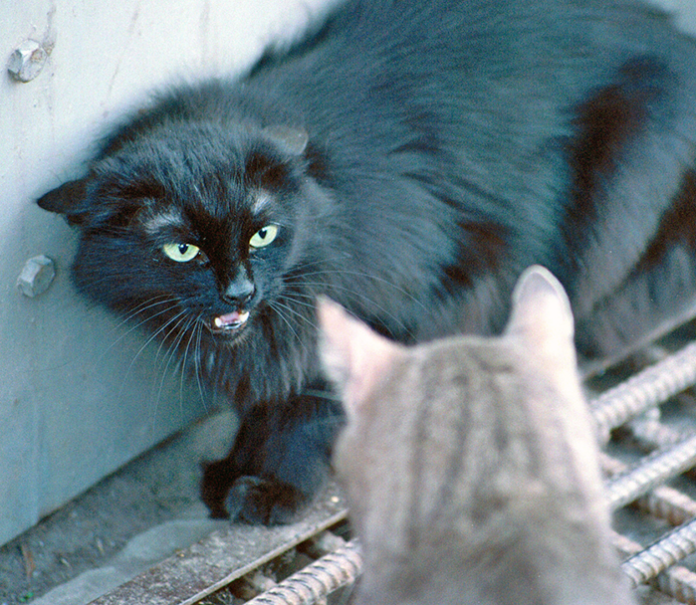Feline interstitial cystitis (FIC) has been frustrating veterinarians for many years. While FIC is the most common diagnosis in cats with lower urinary-tract problems, its exact cause remains unknown.
Cats with FIC show classic bladder problem signs:
- Frequent visits to the litterbox
- Blood in the urine
- Urinating outside the litterbox
The urinary tracts of cats with FIC are (thankfully) not blocked, so they do pass urine, although often in small amounts (the inability to pass urine is an emergency that requires immediate veterinary attention). In cats with FIC, however, the bladder is inflamed, which causes significant discomfort/pain.
Leni Kaplan, DVM MS, lecturer in the Community Practice Service at the Cornell University College of Veterinary Medicine, notes that some owners will report that their cat is having trouble urinating. These cats need to be checked to be sure they can urinate. Some cats will be observed to excessively lick and groom the area around the vulva or penis.
Risk factors for FIC in cats include being male (which means that urinary blockage must be ruled out, as this is more common in male cats), young, overweight, having a nervous temperament, and eating more than 50% of the diet as dry food. Cats in multi-cat households are also overrepresented, which could reflect stress due to limited access to resources like food, water bowls, and litterboxes.
Diagnosis
Diagnosis is a process of elimination. A urine sample will be evaluated to rule out infections and urinary crystals. A blood chemistry panel is usually done to make sure the cat does not have any problems that could be contributing, such as kidney disease. Radiographs or an ultrasound may be done to look for bladder stones or cancer.
A definitive diagnosis can only be obtained via bladder biopsy obtained during a cystoscopic exam (this involves passing a small flexible fiberoptic camera into the bladder). Generally, the diagnosis is arrived at by ruling out other potential causes of the symptoms.
Treatment
The treatment of FIC is generally not straightforward. Data suggest that the bladder is a bit of a “stress” organ that can become inflamed when a cat experiences chronic anxiety (this is true in people as well).
Treatment includes reducing stress in an affected cat’s environment. “Reduction of stress in the cat’s environment is very important to controlling or eliminating FIC,” writes Susan Little, DVM, DABVP, in a recent publication. “Even cats that do not appear anxious or stressed may experience boredom if not properly stimulated.” And this can cause stress.
Urine contains substances that can irritate or damage the cells that line the urinary bladder. If the layer of mucus and glycosaminoglycans that helps to protect the cells of the bladder wall becomes defective or deficient, ulcerated areas can appear. Irritation to nerves in the bladder wall can then cause pain.
Dr. Kaplan suggests a multimodal initial treatment plan:
- Analgesics to address pain. Your veterinarian may use non-steroidal anti-inflammatory drugs, opioids (such as buprenorphine), or gabapentin to address neuropathic pain.
- Medication to help relax the muscles in the urethral sphincter so the cat can urinate more easily. These muscles can become spastic (contracted) after the cat has been straining for a long time.
- Subcutaneous fluids to help dilute the urine so it is less irritating to the inflamed bladder and urethra. The fluids also help flush out the inflammatory debris to help promote healing.
Long-Term Help
These treatments help get your cat through the acute phase of FIC, however, about 50% of cats will have a recurrence within one year of the initial diagnosis. It is in the best interests of your cat to resolve the issues that are suspected to have contributed to FIC in the first place.
“Stress relief including MEMO (Multimodal Environmental Modification) is key to successfully managing these cases. Owners should be counseled regarding best diets for these pets (canned food with some added water always helps; prescription diets are also available). Despite many owners’ best efforts, some cats will need anti-anxiety medications as well. Finally, cats do develop medical conditions (such as bladder stones and urinary tract infections) that cause similar clinical signs, so it is crucial that owners have their pets examined by their veterinarians when they are having an episode or flare of cystitis,” says Dr. Kaplan.
MEMO involves owners taking a critical look at their cat’s environment and detecting areas that are potential stressors, such as the placement and number of litterboxes and food bowls if they have more than one cat. They all should be easily accessible.
Make sure you have safe, comfortable resting and sleeping spots in an adequate number. Ideally, there are some safe “hiding” spots available to your cat. You may need multiple scratching posts.
Cats need enrichment. Food puzzle toys, playing with your cat with a feathered wand, retrieving games, a window seat, and even a fish tank can all provide entertainment for your cat. Rotate toys. Take time to groom, play with, and interact with your cat daily. If you have multiple cats, they each need some private one on one time.
Diet is important. Canned food helps, and encouraging drinking is important to keep urine concentration down and flush the bladder. Dump and replace water daily. Ask your veterinarian about antioxidant and fatty acid supplementation. Some studies have suggested that these may help.
Despite all you do, however, some cats need anxiolytic medications to help their stress. Your veterinarian may prescribe these or may refer you to a veterinary behaviorist. Getting a handle on a cat with FIC may take some effort, but the reward is a healthier, happier feline companion.




